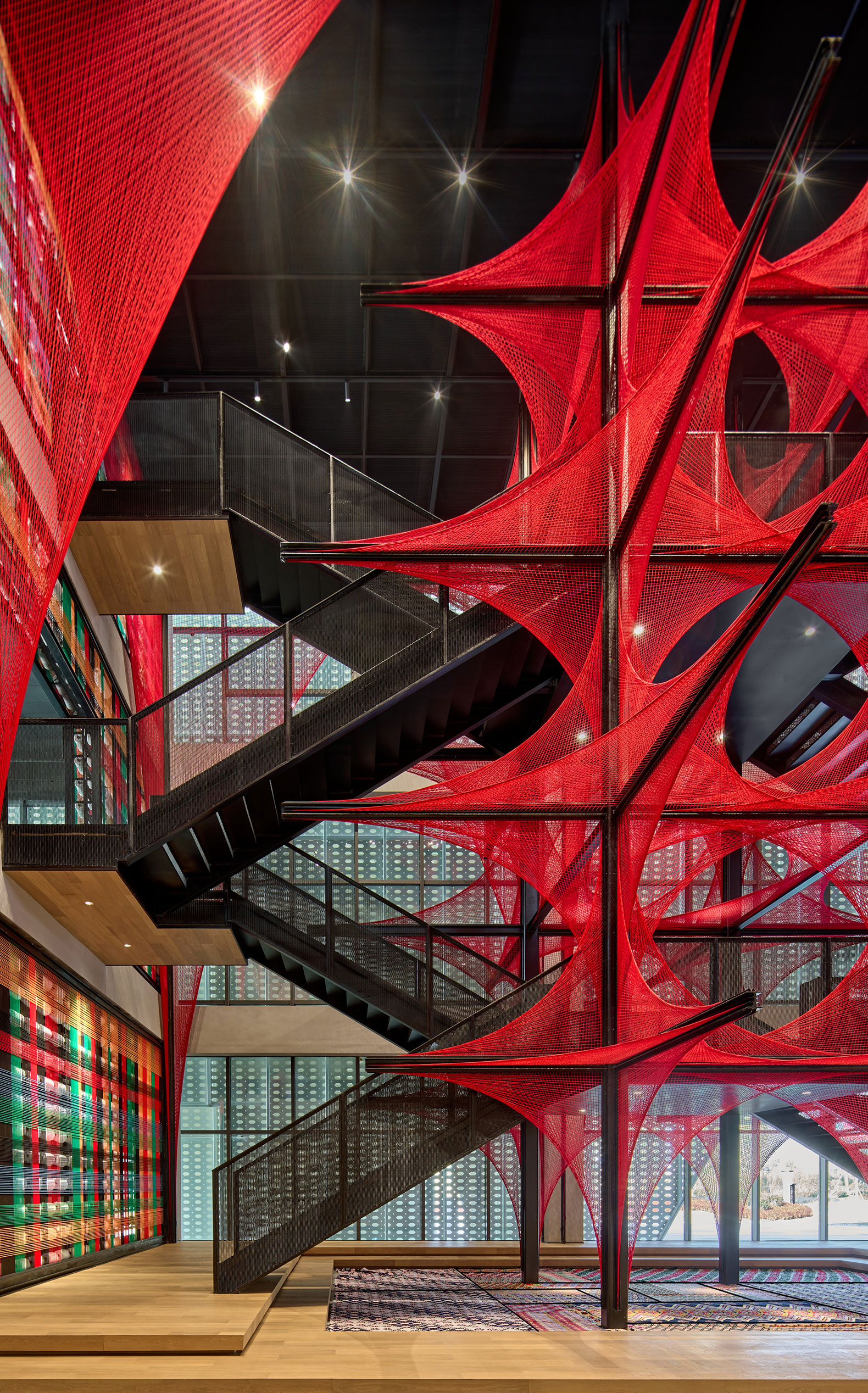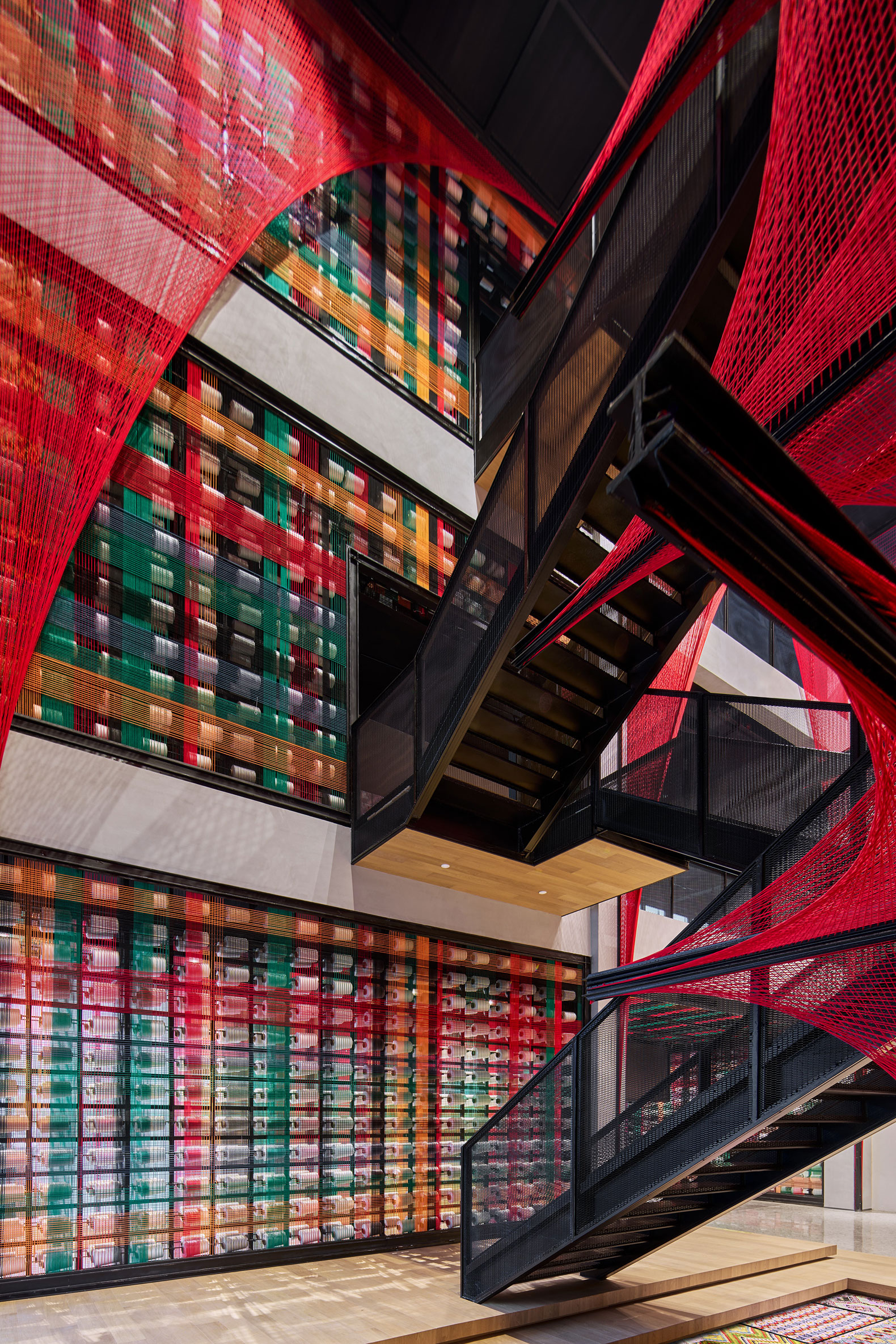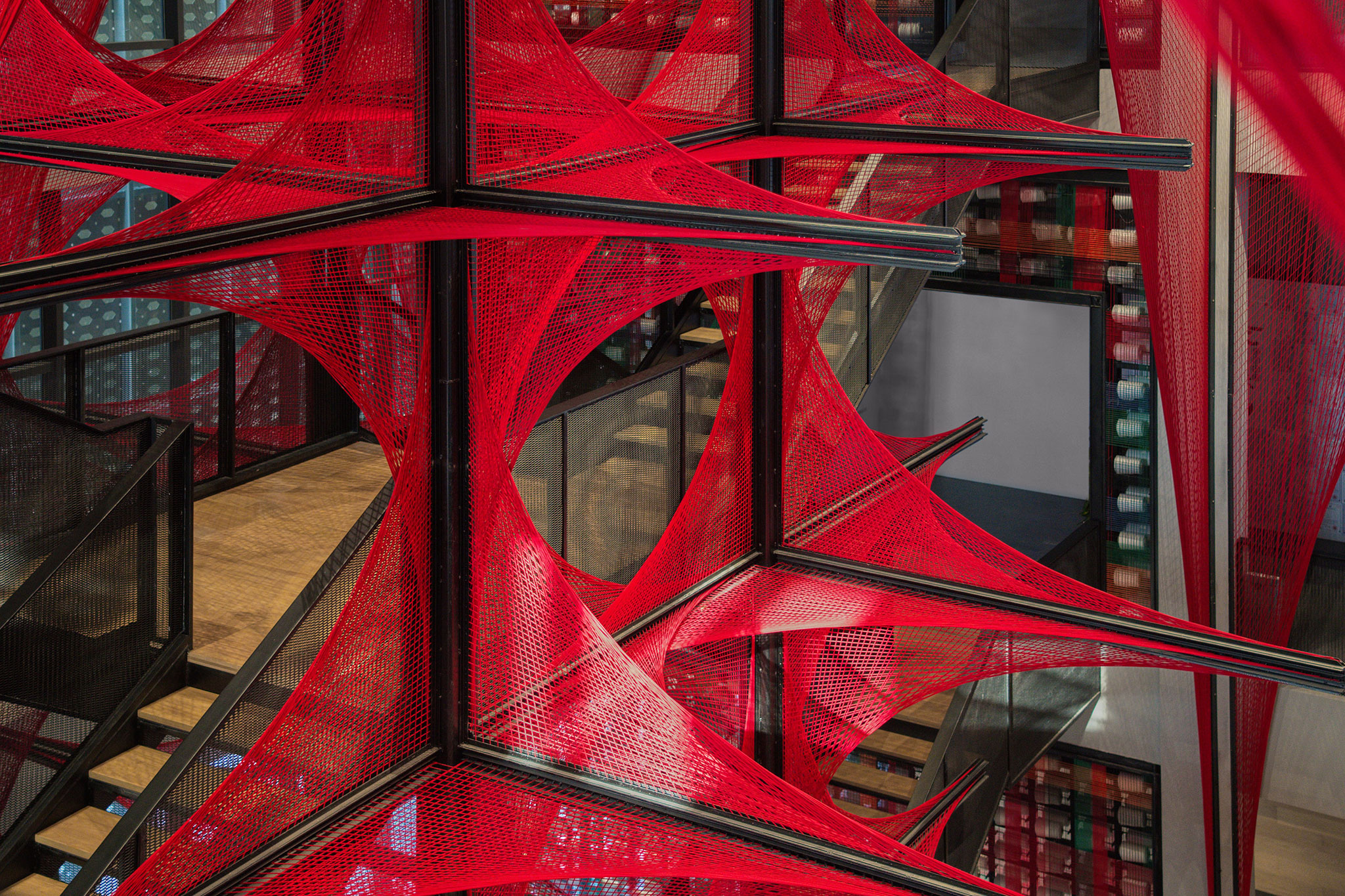The project has made the space around it even more valuable, thanks to the combination of color, location, utility, etc. The space is produced by two staircases, which derive their structure from the hexagon found in the Xilan Kapu pattern of steel, and together with the subtle graphics, the contradiction and tension of the space invite new imaginations. The bottom of the stairs and the installation are elevated, and the floor is paved with Xilan Kapu patterns to allow visitors to access the space and sit on the ground.
The aim of the project is that the museum does not become lifeless if it is not transmitted to future generations, since the modern lifestyle favors efficiency and comfort, regardless of design, practicality or mode of operation.

The Flower of Tujia at the China Tujia Brocade Art Museum by YI+MU Design Office. Photograph by YI+MU Design Office.
Description of project by YI+MU Design Office
"Culture is the super-genetic memory of human beings; it preserves everything from the past".
Yury Ivanovich Borisov.
The way Xilan Kapu, also known as Tujia Brocade, makes people feel is similar to that of the Tujia dialect. That is, they are closely connected to the richness of the land and daily life. Perhaps more importantly though, they are both heading towards extinction if left unprotected.
The main area of the China Tujia Brocade Museum in Zhangjiajie, Hunan Province, was completed in 2022. The giant central installation, the “Flower of Tujia,” is 8m wide, 13m tall, and 8m deep. It is made by 150,000 meters of red brocade threads. It reaches all the way from the floor to the ceiling, compelling people to come closer and explore this traditional handicraft that has remained silent for thousands of years.
The China Tujia Brocade Museum is dedicated to the Tujia brocade handicraft, which is considered to be part of the country’s national intangible cultural heritage. Zhangjiajie Guaiyaomei Tujia Brocade asked YI+MU Design Office to design the interior of the museum. It took them four months to complete the central installation. This collaboration between Vancouver, Beijing, and Zhangjiajie is like a flower slowly blooming across time and space.

The Flower of Tujia at the China Tujia Brocade Art Museum by YI+MU Design Office. Photograph by YI+MU Design Office.
Xilan Kapu
Xilan Kapu is the local dialectal name of Tujia brocade, a traditional craft of the Tujia people. It is woven on a wooden waist loom using hemp or cotton yarn as the warp. Thick, multi-colored silk is used as the plush threads that form the weft.
Xilan Kapu features warm colors and a rigorous structure dominated by geometric symmetry and repeating diamonds and diagonal lines. In 2006, it was included as part of the first batch on the national intangible cultural heritage list under the name “Tujia Brocade.”

The Flower of Tujia at the China Tujia Brocade Art Museum by YI+MU Design Office. Photograph by YI+MU Design Office.
Central Installation the “Flower of Tujia”
Born out of the earth and passion
For the Tujia women who weave these patterns, completing the more than 30 steps to produce Xilan Kapu is like breathing. They weave the ancient Tujia people’s idea of the sun as the fire of life and their burning and peaceful longing for life into the “colorful and visible” Xilan Kapu. This loom technique has been used for thousands of years.
YI+MU Design Office created a symbolic three-dimensional expansion of the single-sided pattern in the 14-meter-high space. The red brocade threads are attached and fixed to the frame, which is made of 20 steel bars. The diamond-shape structure inspired by the iconic pattern of the Tujia brocade is clearly visible from all angles.
At the intersection of the black bones and red blood is the inheritance of the Tujia people, whose fire of life bursts out of the earth. The “Flower of Tujia” is blooming, connecting the primitive life scattered in the depths of time to the colorful and energetic commercial society.

The Flower of Tujia at the China Tujia Brocade Art Museum by YI+MU Design Office. Photograph by YI+MU Design Office.
Spirit of the Venue
From Ancient Legends to New Imaginings
The space around the “Flower of Tujia” is even more valuable thanks to the clever combination of the venue, utility, spirit, and artistic attributes.
A vertical passage is created by two steel staircases, which are connected by two platforms located at the center of the installation, bringing the staircases and the installation together. The linear structure of the industrial staircases is derived from the hexagon found in the Xilan Kapu pattern. It is also used in the hollow shape of the outer steel structure. When the subtle graphics emerge and unfold, the contradiction and tension of the space invite new imaginings.
The bottom of the staircases and the installation are raised, and the floor is paved in Xilan Kapu patterns to allow visitors to access the space and sit on the floor. The design also echoes the stilted buildings of the Tujia people and maximizes the space for the entrants to fulfill the spirit of the venue.

The Flower of Tujia at the China Tujia Brocade Art Museum by YI+MU Design Office. Photograph by YI+MU Design Office.
Outside the central area, the design incorporates simple materials like white oak, textured paint, metal mesh, and terrazzo. Against the gray-black background, a large number of white spindles intersect with five-color threads across the facade and roof to slightly shield the peripheral space and direct the visual focus to the center.
It can be seen when traversing the space that it is free of showy techniques, instead focusing on a concentrated and powerful display. Everything works together to create a space with a clear identity, origin, and aim that is tightly connected with the landscape, culture, and spiritual attributes.

The Flower of Tujia at the China Tujia Brocade Art Museum by YI+MU Design Office. Photograph by YI+MU Design Office.
Value of the Space
Journey upstream and reshape the language
If there is a current, journey upstream.
The rise and fall of an industry is not easily observed by the outside world. Tujia brocade is no exception. The diligence and ingenuity of the women who weave the patterns is reassuring, but there is a gap between traditional crafts and modern life. The modern lifestyle favors efficiency and convenience, regardless of the design, practicality, or mode of operation.
The design features modern aesthetics and art forms, skillfully placing traditional skills in the new space. The interest, emotion, progress, and faith that grow along with art will eventually reshape the language and value of the craft.

The Flower of Tujia at the China Tujia Brocade Art Museum by YI+MU Design Office. Photograph by YI+MU Design Office.
The objects displayed in the museum will be lifeless if they are not passed down to future generations. We need living skills. This is also the original aspiration and hope of the client and YI+MU.
“Tujia brocade, Xilan Kapu, beautiful floral cloth, gorgeous pearl Weave, weave, weave, weave, a golden phoenix flies out of the tapestry”.



























































